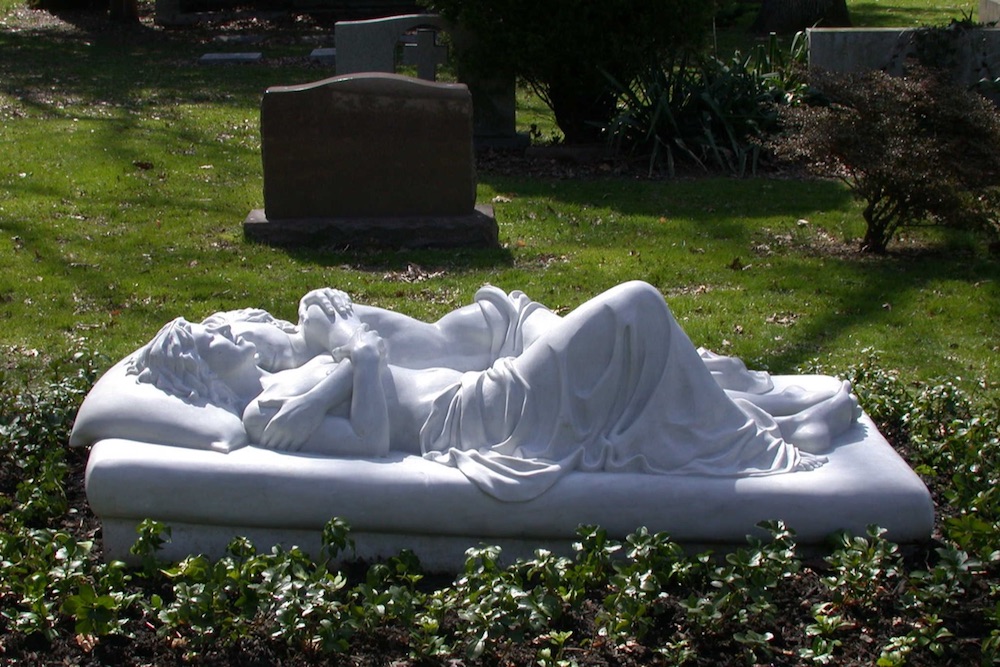
Memorial To A Marriage, Carrara marble, overlie size, 2002, Cronin Kass plot, Woodlawn Cemetery, Bronx, NY. Image courtesy of Patricia Cronin Studio, LLC.
It must be their feet tangled past the hem of the blanket
(a big toe pressed to the top of a pale, carved foot)
that make me pause, scroll back to this image:
two women embracing in marble, hair loose,
eyes closed: their polished mouths smiling.
I touch the picture and their bed fills the screen: Life scampers
across their likeness in this public cemetery. Grass brushes
their pallet: a tree casts leaf-dapple across their shoulders,
and a little pool of rain water gathers in the furrow
between their bellies. I want to call you (from the other
side of the house): look at this, their bed is our threadbare
bedspread with blue flowers and flattened pillows: I can find us
all over their particulars: one’s chin and another’s chest:
my stomach, your hip: my shin pressed against your shin:
but you are reading, alone in your bath, in a cloud
of your own breath, in a nakedness that doesn’t include me.
They exist. This marriage exists. What does it mean to carve a living thing
in stone? (2002-eternity.) I have lived things that felt eternal, sure:
my own dazzling afternoons on ferries, crossing cold waters,
at an iron railing watching pine trees pass (Just as you feel
when you look on the river and sky, so I felt), I learned to fling myself
across distance: I wished: I said, “From your mouth to God’s ear.”
And I have wanted to live behind that ear, too, tucked like a flower,
in a fold of eternity. On my screen a small leaf
sets sail across the water between their two bellies, sallying
along the shores of these sleeping lovers. Didn’t Whitman say queers
should stand on the shoreline calling out, “I was, I am” to journeyers
from the future, as they sail past us in paper boats? I will;
I do. “What I can’t have in life, I will have in death,”
the artist says: a marriage, seen. Is this what living in public means?
And what do we know about life in public? We drop hands. You and I
and your husband have no papers, portrait or family name. In a million
iterations of lords and ladies holding hands on their marble
caskets, what will survive of us is almost nothing: still, maybe
a glimpse: these brides’ bodies are bright, glittering,
off-set against dark grass. They establish themselves as the land.
Oak leaves nestle in the hollow between one’s chin and another’s chest.
Their marble shoulders are freckled with acid rain. I want to shelter here,
in their bed’s shining visibility: they let us be seen while keeping
our privacy: we leapfrog from now to someday to escape while we are still here.
I go upstairs and find you in the water. I take my clothes off
and climb in. We barely fit in this casket together, thigh to shin,
knee to knee. Around us, ripples in concentric circles spread
to the basin’s edge and then return to our shimmering
bullseye: we are what we were setting out to see.
Notes on the poem:
“Memorial to a Marriage” responds to Patricia Cronin’s sculpture, Memorial To A Marriage. “What I can’t have in life, I will have in death” is a quotation from Garden Castro’s “Making the Personal Monumental: A Conversation with Patricia Cronin.” This poem cites Walt Whitman’s “Crossing Brooklyn Ferry” and Phillip Larkin’s “An Arundel Tomb.”



